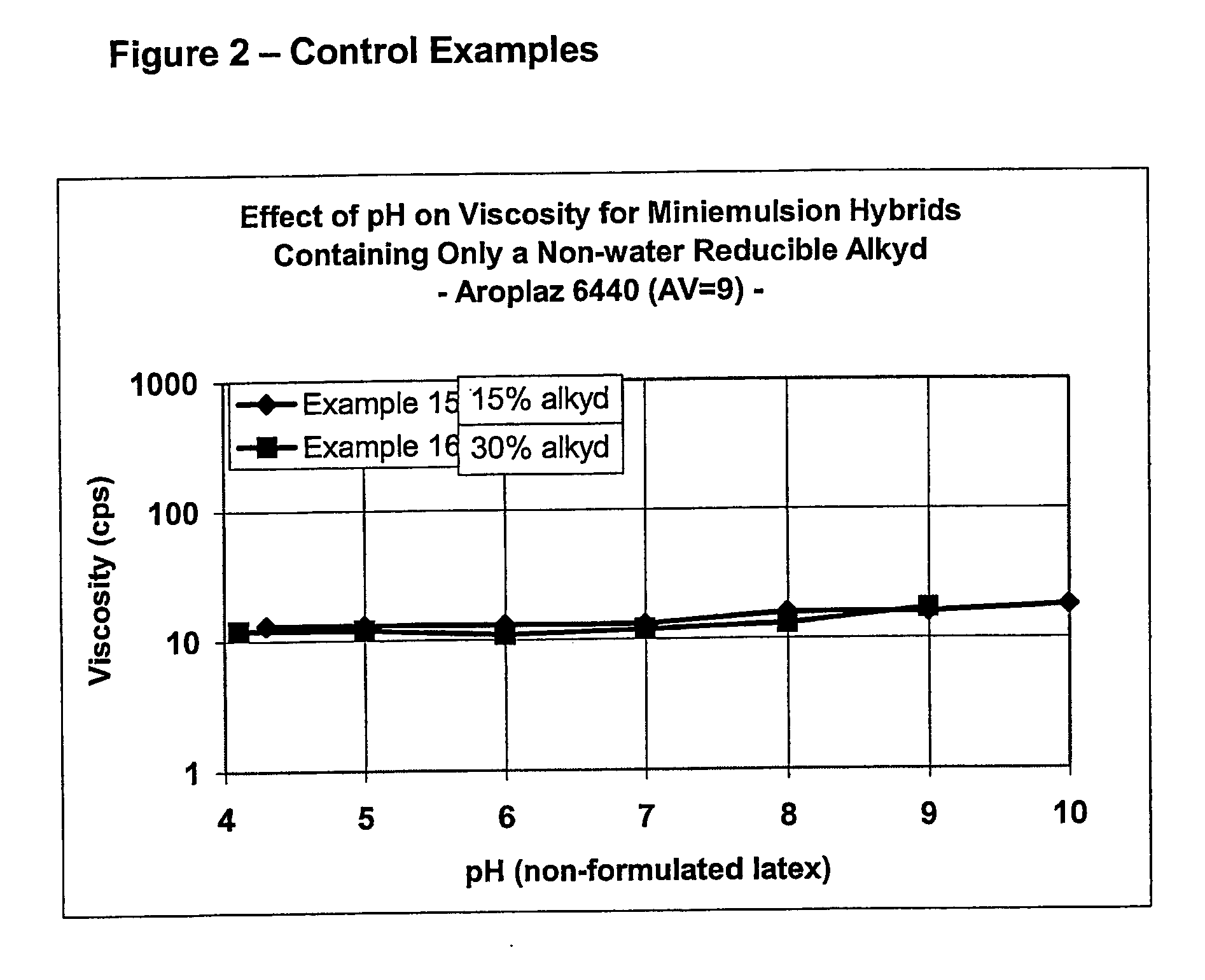Acrylic-modified alkyd hybrid latexes and their use as viscosity modifiers
a technology of alkyd resin and viscosity modifier, which is applied in the field of alkyd/acrylic hybrid latex polymers, can solve the problems of low viscosity of traditional alkyd resin, high organic solvent requirements, and poor flow and leveling characteristics of these latex resins, and achieve high levels of expensive thickening agents, suitable film forming properties, and good flow and leveling characteristics
- Summary
- Abstract
- Description
- Claims
- Application Information
AI Technical Summary
Benefits of technology
Problems solved by technology
Method used
Image
Examples
examples 1-16
[0089] For each of examples 1-16, to a 1000 mL resin kettle equipped with a condenser, nitrogen purge, and a subsurface feed tube were added 122 g of water. A nitrogen purge was begun and the contents heated and maintained at 80° C. The alkyds indicated in Table 1 were added to the monomer mix and dissolved. (Refer to Table 1 also for latex composition data.) Water and surfactant(s) were premixed, then the monomer / alkyd mix was added to form a pre-emulsion. Surfactants included Aerosol OT-NV (Cytec Industries) and / or Hitenol BC1025 (DKS). 4.5 g of ethylhexyl mercaptopropionate was added to the pre-emulsion for molecular weight control of the polymer. The pre-emulsion was sheared using an IKA (Model SD-45) rotor / stator homogenizer by pumping through a flow cell which surrounded the shearing device with the homogenizer operating at 100% output to form a miniemulsion. 80.4 g (10%) of the miniemulsion was charged to the reactor. 0.60 g of ammonium persulfate was mixed in 10 g of water a...
examples 17-28
[0094] For each of examples 17-28, to a 1000 mL resin kettle equipped with a condenser, nitrogen purge, and a subsurface feed tube were added 122 g of water. A nitrogen purge was begun and the contents heated and 30 maintained at 80° C. The alkyds obtained from a commercial source (Duramac 74-7474 and Duramac 57-5816, Eastman Chemical Company) were added to the monomer mix and dissolved. The water-reducible, high acid value alkyd (Duramac 74-7474) was not reduced in water, but dissolved directly in the monomer mixture. (Refer to Table 3 for latex composition data.) Water and surfactant(s) were premixed, then the monomer / alkyd mix for stage 1 was added to form a pre-emulsion. Surfactants included Aerosol OT-NV (Cytec Industries) and / or Hitenol BC1025 (DKS). 4.8 g of isooctyl mercaptopropionate was added to the pre-emulsion for molecular weight control of the polymer. The pre-emulsion was sheared using an IKA (Model SD-45) rotor / stator homogenizer by pumping through a flow cell which ...
PUM
| Property | Measurement | Unit |
|---|---|---|
| particle size | aaaaa | aaaaa |
| droplet size | aaaaa | aaaaa |
| droplet size | aaaaa | aaaaa |
Abstract
Description
Claims
Application Information
 Login to View More
Login to View More - R&D
- Intellectual Property
- Life Sciences
- Materials
- Tech Scout
- Unparalleled Data Quality
- Higher Quality Content
- 60% Fewer Hallucinations
Browse by: Latest US Patents, China's latest patents, Technical Efficacy Thesaurus, Application Domain, Technology Topic, Popular Technical Reports.
© 2025 PatSnap. All rights reserved.Legal|Privacy policy|Modern Slavery Act Transparency Statement|Sitemap|About US| Contact US: help@patsnap.com



